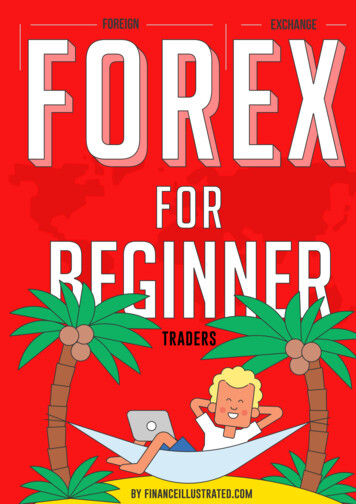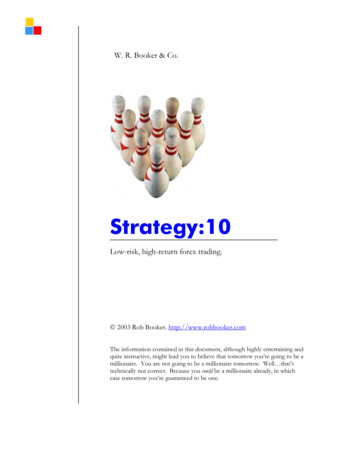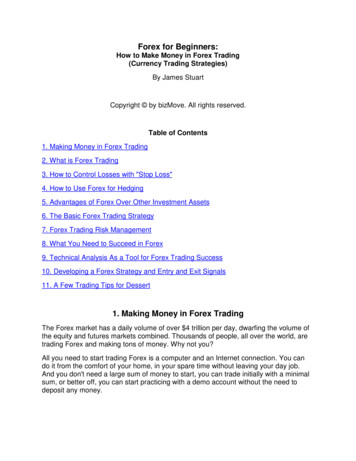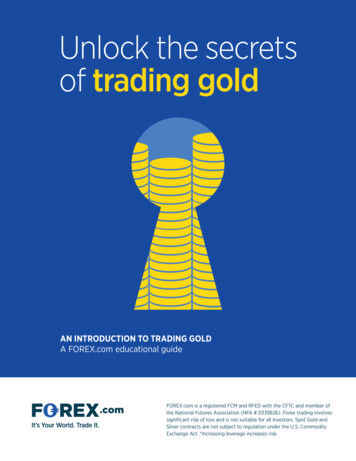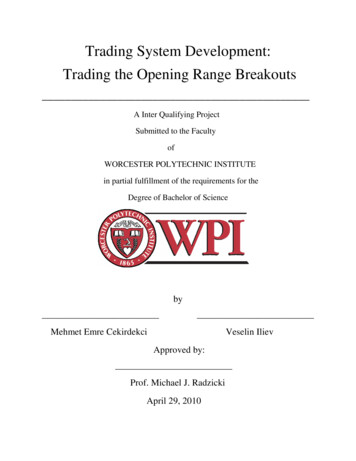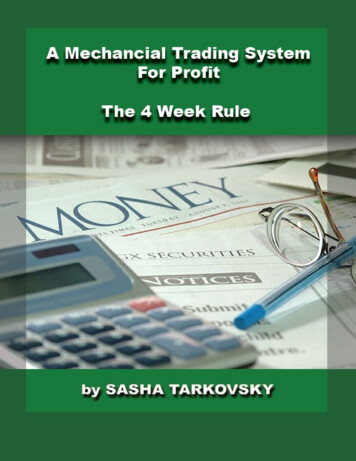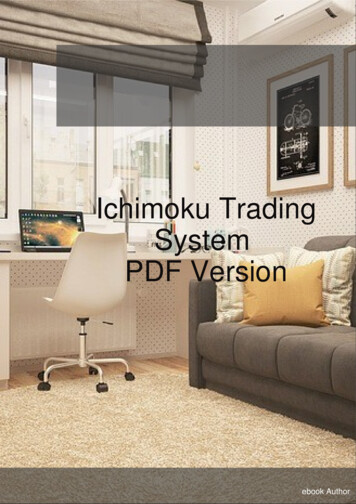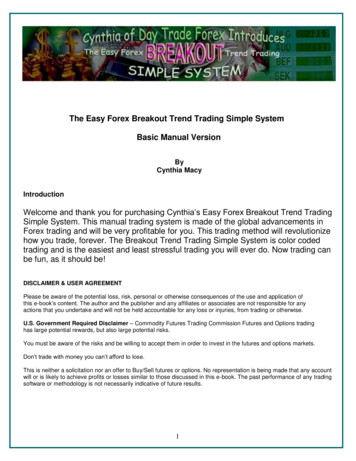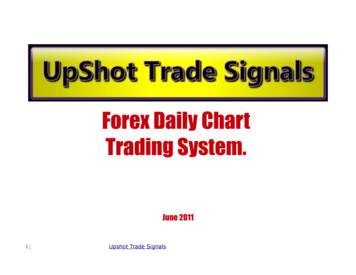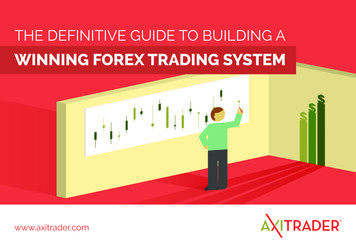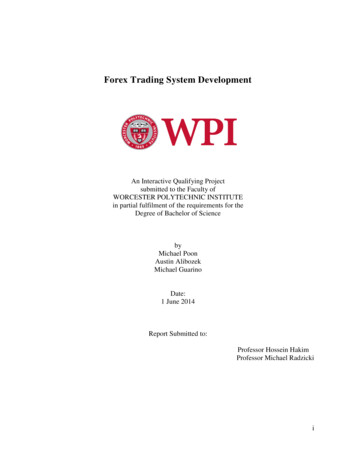
Transcription
Forex Trading System DevelopmentAn Interactive Qualifying Projectsubmitted to the Faculty ofWORCESTER POLYTECHNIC INSTITUTEin partial fulfilment of the requirements for theDegree of Bachelor of SciencebyMichael PoonAustin AlibozekMichael GuarinoDate:1 June 2014Report Submitted to:Professor Hossein HakimProfessor Michael Radzickii
AbstractThe focus of this report is to demonstrate the process of building a trading system to beused in the foreign exchange market. The report will introduce an overview of the currencymarket and different trading techniques and concepts used in the construction of a tradingsystem. The process of building a forex trading strategy, from initial formation to optimization,is laid out based on existing research. The results and analysis of the group’s own experiencebuilding and testing a forex strategy is included to exhibit the method presented in the report.i
Table of ContentsAbstract . iTable of Figures . iv1Introduction . 11.12Background . 32.1Trading Markets . 32.1.1Stocks . 32.1.2Commodities . 52.1.3Forex . 61.2.2Forex . 6Overview of Forex . 82.2.1History of Forex . 82.2.2Currency Pairs . 92.2.3Market Structure . 112.2.4Trading Sessions . 122.2.5Leverage . 132.3Analysis Techniques . 142.3.1Fundamental Analysis . 142.3.2Market Sentiment . 192.3.3Technical Analysis . 222.43Project Description . 2The Trading System . 362.4.1Selecting a Currency Pair. 372.4.2Market Analysis . 372.4.3Trading Style . 382.4.4Risk Management and Position Sizing . 39Methodology. 403.1.1Establishing an Understanding of the market . 403.1.2Learning Trading Mechanics . 413.1.3Research of Technical and Fundamental Analysis . 413.1.4Testing and Evaluating Trading Strategies . 42ii
45Process . 444.1Strategy I Process . 444.2Strategy II Process . 544.3Strategy III Process . 61Results . 695.1Gain an Understanding of Forex . 695.2Define Trading Personality . 695.3Select Useful Indicators . 705.4Define Entry and Exit Rules. 705.5Manage Risk . 715.6Trade the System . 71Appendices . 72Appendix A. Exchange Rate Theories and Models . 72Purchasing Power Parity. 72Interest Rate Theories . 73Monetary Theory . 73Appendix B. Weekly Reports. 75Weekly Report - 2/6/14 . 75Weekly Report – 2/27/14 . 85Appendix C. Trading Logs . 93Strategy I Trading Log . 93Strategy II Trading Log . 95Strategy III Trading Log . 98Appendix D. EasyLanguage Code . 100EL Strategy I – Strategy . 100EL Strategy II – Strategy. 102EL Strategy III - Indicator . 1026References . 106iii
Table of FiguresFigure 1 – Diagram of Forex Market Structure . 12Figure 2 – Example of Simple Moving Average Indicator. 26Figure 3 – Example of Moving Average Divergence Convergence Indicator . 28Figure 4 – Example of Bollinger Bands Indicator . 30Figure 5 – Example of Relative Strength Index Indicator . 33Figure 6 – Example of Stochastic Indicator . 35Figure 7 – Strategy I 2-Line SMA Strategy Chart . 47Figure 8 – Strategy I: MACD Momentum Strategy Daily Chart. 49Figure 9 – Strategy I: MACD Momentum Strategy 4-hour Chart . 50Figure 10 – Strategy I: MACD Momentum Strategy 1-hour Chart . 50Figure 11 – Strategy II: Example of a 2-line Moving Average Crossover . 57Figure 12 – Strategy II: Bollinger Bands Strategy. 58Figure 13 – Strategy II: RSI and 2-Line Moving Average . 59Figure 14 – Strategy III: 3-Line SMA Strategy Chart . 64Figure 15 – Strategy III: RSI Strategy Chart . 66Figure 16 – Strategy III ASI Parabolic SAR Strategy Chart . 67Figure 17 – Weekly Report: Simple MACD trading strategy . 76Figure 18 – Weekly Report: Simple stochastic scalping strategy. 77Figure 19 – Weekly Report: Example of 2-line moving average . 80Figure 20 – Weekly Report: Moving Average/RSI Strategy . 84Figure 21 – Weekly Report: RSI indicator application . 89Figure 22 – Weekly Report: Updated Trading Strategy with Parabolic SAR . 92iv
1 IntroductionInvesting has always served as a tool used to manage personal finances. In this day and age,with the assistance of technology, people have the ability to control the interests composing theirinvestment portfolio. The main idea behind investing money is to generate revenue, in turneasing the burden of saving for retirement and unforeseen expenses. Conventional methods ofmanaging money typically employ the allocation of specified funds to a savings account, underthe impression that untouched capital will gradually accumulate interest. Among the morelucrative, and consequently more precarious, approaches to developing an investment planinvolves the placement of funds within the various markets available to the financial community;this is done in hopes that the devotion of funds to a particular emerging asset will allow forgreater returns than those characteristic of an equivalent stationary deposit in either a savingsaccount or retirement fund. Regardless of the investment technique selected by an investor,however, this individual must prepare themselves to combat the realities of constantly changingasset prices and rates of interest. The strategies associated with doing so formulate thegroundwork for an investment technique referred to as trading.Rather than subjecting a portfolio to the concurrent benefits of an appreciating investmentand sufferings of a depreciating one, trading is often aimed at avoiding the oscillationscharacteristic of a stationary investment. Trading is, however, a skill as much as it is an art;similar to any investment opportunity, trading puts the designated capital at risk. Therefore, inorder to reduce the level of risk associated with such investments, a trader must develop apersonal strategy allowing for the educated and intelligible delegation of capital. When thenecessary precautions are taken, including the adherence to a prearranged plan, this method ofmanaging personal finances can prove incredibly worthwhile. If an individual is willing to adopt1
the increased risk associated with this technique, they can substantially increase the profitabilityof their financial portfolio; the benefits of trading, when executed properly, have the potential tooutweigh those of any other investing strategy.The foreign exchange market is a generally new sector making trading investments thathas been gaining popularity within the past decade. The combination of the global scope of themarket and the constantly growing trading volume make forex a low risk option whentrading. However, like most financial markets there is a learning curve for new traders enteringthe market. Current resources available cover the concepts behind the market but few go indepth on how to trade currencies.1.1 Project DescriptionThis project aims to fill the gap in existing research on building a trading system toeffectively trade currencies in the forex market. Utilizing existing research together
The process of building a forex trading strategy, from initial formation to optimization, is laid out based on existing research. The results and analysis of the group’s own experience building and testing a forex strategy is included to exhibit the method presented in the report. ii.

